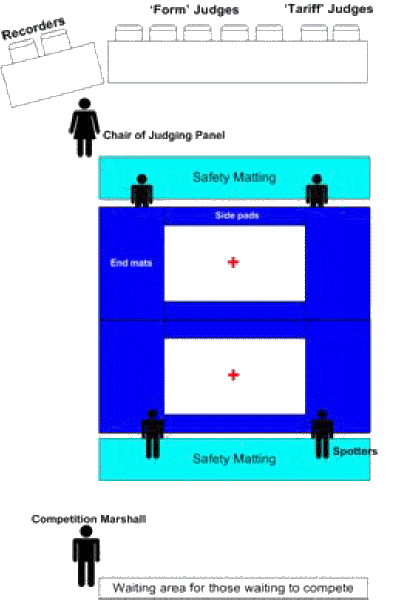OCR PE Unit 6.4
Gymnastics Based Sport - Trampolining
Most Important Rules
- Men and women compete in different competitions, not together
- At the qualifying stage in the Olympics, a trampolinist has to complete an optional and a compulsory routine, in the final they only do an optional routine
- A compulsory routine contains a set of skills that need to be performed in a set order
- An optional routine contains a set of 10 recognized skills
- Routines should end with the trampolinist in a upright position with both feet in contact with the trampoline bed
- If the trampolinist falls or 'wobbles' then points are deducted
- Unless a routine is interrupted by something not to do with the routine then the routine can be performed again
- A routine can only be performed once
- Moves should look well performed and have form and posture, e.g toes pointed
- There is no time limit to any routine
- If the difficulty of the move is hard then the trampolinist will score higher
Officials and Judges
In trampolining there are many judges and officials. They are -
- Form Judges - there are five form judges who score the execution of the routine.These judges begin with 10 points for every jump (perfect score) and deduct points for mistakes. The form judges decide how well the trampolinist has perfomed their routine. The form judges look for deductions of points in the following ways: loking for a trampolinists inconsistent height, their failure to land on the cross each time, their poor form and shape and failure of set skills. The way in which points are deducted are by deducting 0 points which is a perfect move or 0.5, a very bad move.
- Tariff Judges - there are normally two tariff judges at a competition. These judges recognise moves and also pass judgement on it. For example if in qualifying a performer performs a set routine incorrectly they need to assure the Chair of the error. The Chair then tells the form judges of the mistake and they then deduct for the mistake. Tariff judges hold up score cards to the Chair for him to read out.
- Recorders - The role of the recorders is to 'record' the deductions made by the form judges. other judges need to ask the recorders for immediate confirmation of the scores if they are not clear with a decision. If a judge makes a mistake of a move then the recorders make an average of the jumpers score per move and use this to calculate the score of the move. In more important and tense situations such as the Olympics there will be a manual and computer scorer and recorder. If a tie occurs then the winner is declared by assessing the performer with the highest voluntary score and the performer with the highest form scores by 5, then 4 then 3 judges until the tie is broken.
- The warm up marshalls - The warm up marshalls role is to, during warm up, controll the competitors. This role is simply allocated to ensure that every performer has a faie chance to warm up.
- The competition marshall - The competition marshalls role is that once the warm ups are over, the competition marshall takes over and the 'marshalling' is down to this person. The competition marshall will normally start by sitting the performers down in their competition order and verify that they are present, and briefing everybody on the importance of listening for their name when called.
- The spotters - There are two spotters and it is their role to watch the performer at all times in case they need help to stay on the trampoline if in difficulty. Although they are allowed to do this they cannot help the trampolinist to reduce deductions. They just hold the trampoline if it is moving or wobbling etc. Spotters must be tall so they can see above the surface of the trampoline.
- The chair of judges - It is the chair of judges role is to make sure that each performer is correctly identified and complying with all safety rules and that the judges are ready to mark them. They ensure the marking is faie and also anounce important erros to the form judges.
The layout of the judging panels and where the trampoline is located is -
Below a diagram illustrates how the deducting system works -
Body Positioning (Move) | Perfect Move | 0.1 Deduction | 0.2 Deduction | 0.3 Deduction |
Bending Legs |  |  |  |  |
Pointing of toes |  |  | ||
Pike Jump |  |  |  |  |
Straddle Jump |  |  | ||
Tuck Jump |  |  |  |  |
Landing |  |  |

No comments:
Post a Comment